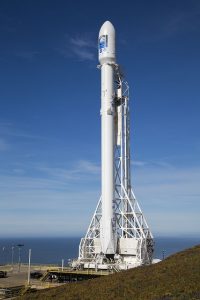
A critical SpaceX mission blasted off from Vandenberg Airforce Base at 10:42 a.m., despite foggy conditions Jan. 17.
Hawthorne-based SpaceX used a Falcon 9 rocket to launch a weather satellite into orbit, which the National Oceanic and Atmospheric Administration will use to monitor ocean wave heights to track and measure the strength of hurricanes. The Falcon 9 also attempted to land on a ship sitting off the coast of Southern California, but sustained damage during the landing.
Thousands of rocket gazers gathered on the sides of nearby roads and in parks to watch the first Falcon 9 launch from Vandenberg Air Force Base since Sept. 29, 2013.
After the Falcon 9 put the Jason-3 in orbit, the hardest part of the mission came. Attempts to land the first stage of the rocket on ships, known as drone ships, in January 2015 and April 2015 failed. April’s attempt hovered over the landing platform, but tipped over and then exploded. A June launch from Cape Canaveral, Fla. broke up just minutes after takeoff.
The Vandenberg launch came just weeks after a Dec. 22 launch where SpaceX launched a Falcon 9 from Cape Canaveral, and landed it on dry land.
SpaceX rockets cost between $60 million and $90 million. The company wants to develop reusable rockets to save money on the cost of building new rockets for each launch. If the technology is developed correctly, it has the potential to drastically cut the cost of space travel.
At just 300-feet long by 100-feet wide, the drone ship is a small target. Legs on the first stage of the Falcon 9, are 70-feet wide, but the ship is not anchored and moves in the sea. Landing on dry land is easier, but landing at sea is safer, SpaceX said leading up to the launch.
“If you are coming back at higher speed, a small error can mean a large miss distance,” Scott Pace, director of the Space Policy Institute at George Washington University told Bloomberg News. “For safety purposes, you have a wider area to work with a drone ship.”
SpaceX founder Elon Musk initially tweeted the rocket had a hard landing on the drone ship and broke a leg off the rocket. A photo Musk later tweeted of the damaged rocket laying on its side on the ship.
Definitely harder to land on a ship. Similar to an aircraft carrier vs land: much smaller target area, that’s also translating & rotating.
— Elon Musk (@elonmusk) January 17, 2016
However, that was not what prevented it being good. Touchdown speed was ok, but a leg lockout didn’t latch, so it tipped over after landing.
— Elon Musk (@elonmusk) January 17, 2016
Musk also tweeted that he is optimistic about landing on drone ships.
Well, at least the pieces were bigger this time! Won’t be last RUD, but am optimistic about upcoming ship landing. pic.twitter.com/w007TccANJ
— Elon Musk (@elonmusk) January 17, 2016
SpaceX later said the rocket had a soft landing, but the third landing leg did lock properly. The landing, however, was within 1.3 meters of the center of the drone ship the company said.
The Jason-3, which will also monitor weather in commercial shipping lanes. NOAA is replacing the Jason-2 satellite, launched in 2008, with the Jason-3 so the Jason-2 can map the ocean floor.
-Contact Philip Joens at pjoens@pacbiztimes.com






 Print
Print Email
Email
















